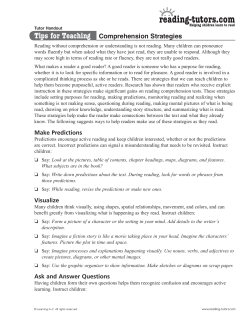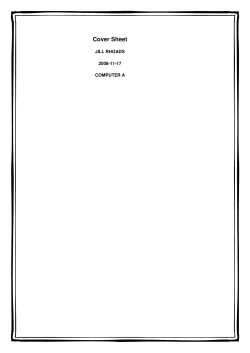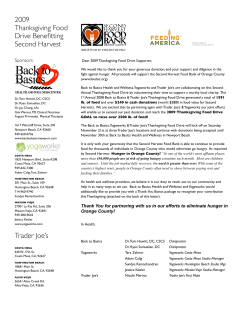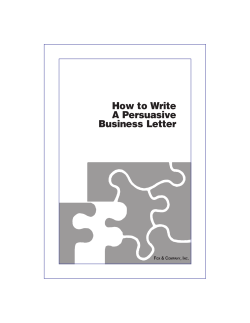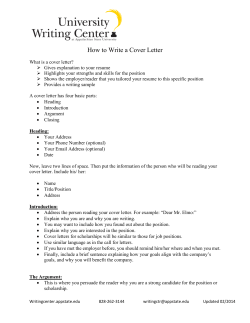
Teacher Copy: Assessment for Independent Reading Levels Levels A-K (Fiction/Narrative) Set 2
Teacher Copy: Assessment for Independent Reading Levels Levels A-K (Fiction/Narrative) Set 2 Reader’s Name____________________ Grade________ Date_________ Level G Independent Level: Yes No Accuracy Rate: _______ Excerpt from Fancy Dance by Leslie Johnson Set 2, Level G 155 Words Book Introduction: Show the cover of the book to the student and say this to the reader before he or she begins reading: “The title of this book is Fancy Dance. In this story a Native American boy named Joe dances his first fancy dance at a powwow. A powwow is a celebration where people dress up, dance and sing. Let’s read to find out what happens to Joe at the powwow.” E E Check the reading behaviors you notice the child using. These notes may not determine the reader’s independent reading level, but will inform your teaching: □ Reads increasingly more difficult words, using letter sounds and word parts. □ Uses parts from known words to read unknown words. □ Begins to monitor, cross-check sources of information and self-correct at the point of error. Some rereading or skipping to go on may be necessary. Running Record: Student will read the first 100 words aloud and the rest of the text silently. Code and analyze miscues for the first 100 words. You may also choose to record and analyze miscues after 100 words for more information. Pg. 2: This is Joe’s first big powwow. He is going to dance the Fancy Dance. Pg. 3: Joe wears a special dance costume. It is red and white. He wears silver bells around his legs. Pg. 4: Joe looks around at the other dancers. They are from many Native American backgrounds. Pg. 5: They wear beadwork and bells. □ Integrates sources of They wear feathers and fringe. information: checks to make sure what has been read makes sense, sounds right and looks right. They wear many bright colors. □ Reads with more phrasing and intonation responding to print features (punctuation, large print). August, 2013 Pg. 6: Joe and the other dancers walk into the dance circle. Pg. 7: There are many people watching. Joe feels a little shy. TCRWP SC M S SC V M S V Set 2 Teacher Copy: Assessment for Independent Reading Levels Levels A-K (Fiction/Narrative) Level G E E □ Reads increasingly more difficult words, using letter sounds and word parts. □ Uses parts from known words to read unknown words. □ Begins to monitor, cross-check sources of information and self-correct at the point of error. Some rereading or skipping to go on may be necessary. □ Integrates sources of information: checks to make sure what has been read makes sense, sounds right and looks right. □ Reads with more phrasing and intonation responding to print features (punctuation, large print). SC M S SC V M Pg. 8: Joe looks at the singers and drummers. They are ready. Joe is nervous. Pg. 9: Suddenly the drummers start drumming. The / singers start singing. (100 words) The Fancy Dance begins! Pg. 10: Joe takes a deep breath. He bends over and he lifts his knee high. Pg. 11: Step! Step! Step quickly! Joe dances fast. Pg. 12: He hops! Pg. 13: He whirls! Pg. 14: Then the singers stop singing. The drummers stop drumming. Pg. 15: The dancers stop dancing. Pg. 16: Joe smiles. He has danced the Fancy Dance just right. Total miscues including self-corrected: _____ Self-corrections: _____ Miscues reader did not self-correct: ______ August, 2013 Accuracy Rate: Circle the number of miscues the reader did not self-correct. 100% 99% 98% 97% 96% 100 words 0 miscues 1 miscue 2 miscues 3 miscues 4 miscues 155 words 0 miscues 1-2 miscues 3 miscues 4-5 miscues 6 miscues 96%-100% accuracy is necessary to determine the reader’s independent reading level. Try a lower level text if the reader does not achieve this level of accuracy. TCRWP S V Teacher Copy: Assessment for Independent Reading Levels Levels A-K (Fiction/Narrative) Set 2 Level G Literal and Inferential Retelling or Summary Say, “Please tell what happened in this story.” Write notes regarding the student’s retell on the back of this page. If the student has trouble getting started, prompt him/her to look at the text. Say, “What happened first?” Make a note that you prompted the student. Some students will retell the story sequentially in response to this prompt, while others will retell the gist of the story. Either response is acceptable here. Use the Retelling Rubric and Sample Student Responses to determine if the child’s retell and response to the comprehension questions are acceptable. If a student is not able to retell but is able to answer the comprehension questions, note that this student will need extra work on how to retell a story. Comprehension Questions Section: Analyze the student’s retelling/summary to see if it contains information that answers each question below. If a question was not answered in the retelling, ask it and record the student’s response. 1. Literal Question: What is Joe getting ready to do at the beginning of the story? 2. Literal Question: Describe Joe’s costume. 3. Inferential Question: Before he started dancing, why do you think Joe felt shy? 4. Inferential Question: Can you tell me how Joe’s feelings change from the beginning of the story to the end of the story? Final Score Yes No Was the reader’s accuracy rate at least 96%? Yes No Did the reader demonstrate understanding of three out of the four comprehension questions? (The child may answer the questions through retelling, and/or may need the teacher to ask the questions directly.) Please note: If the child’s retelling includes answers to comprehension questions, do not ask the questions over again. Mark the question as answered correctly. Only ask the comprehension questions that were not already addressed in the child’s retelling. Is this the student's independent reading level? If you did NOT answer “yes” to all questions in this Final Score box, try an easier text. Keep moving to easier texts until you find the level at which you are able to answer “yes” to all questions in the Final Score box. If you circled two “yes” answers in this Final Score box, the student is reading strongly at this level. However, it is possible that the student may also read strongly at a higher level. Keep moving to higher passages until you can no longer answer “yes” to all questions. The highest level that showed strong reading is the independent reading level. For example, you might find that you answered “yes” to all questions in the Final Score box for level G, then a “yes” to all questions for level H, but only one “yes” answers for level I. Level H is the highest passage on which you were able to answer “yes” to all questions in the Final Score box. Level H is the current independent reading level for the student. August, 2013 TCRWP
© Copyright 2025

